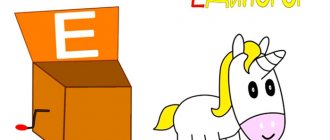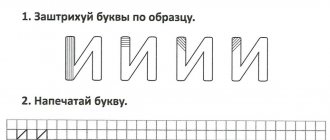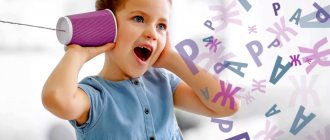Literacy training “Sounds [f], [f`] and the letter F”
Today we will start our online lesson with something very, very useful and very, very tasty! And, of course, we will get acquainted with new sounds and letters. Shall we begin?...
Name it in one word: pear, apple, apricot, kiwi, peach,... That's right, these are fruits. Continue the series…..
Fruit
(lat.
fructus
-
fruit
) - a juicy edible fruit of a tree or shrub.
Fruits are an essential part of a healthy diet as they contain various vitamins necessary for the body.
What do you know about fruits?...
Do you know that...
There are 7,500 varieties of apples . And the peel of an apple contains much more useful substances than the pulp.
Kiwi unlike citrus fruits, has the largest amount of vitamin C.
Banana is the fruit of a herbaceous plant.
A sour fruit like lemon contains more sugar than sweet strawberries.
Pumpkin, melon and watermelon are berries.
In Japan, they learned to grow cube-shaped watermelons and melons. Such berries are convenient to transport.
In the EU countries, the following are considered fruits: carrots, tomatoes, rhubarb, cucumbers , sweet potatoes , ginger, pumpkin . Even jams and preserves are made from them.
We are accustomed to thinking that strawberries, blueberries, blackberries, cranberries, and raspberries are berries. But according to botany (the science of plants), they are NOT berries.
A berry is a fruit. And grapes, avocados, eggplants, sweet peppers, and tomatoes are also scientifically berries.
Avocado is sometimes called the “ideal” fruit because it contains almost all the vitamins and minerals you need.
You can learn about the most unusual fruits here.
Why did you decide to talk about fruits today? Because our new sound is the first sound in the word fruit. Say the sound. What is he like? Does the sound [f] a “soft” friend? Prove it.
1. Repeat the words : “Faya”, “Faina”, “candy wrapper”, “last name”, “flashlight”, “fountain”, “myth”, “telephone”, “snort”, “pheasant”. 2. “Who is attentive?”
- Find the same sound in the words: apron, camera, flashlight, flag.
- Guess the boy's name by the first sounds of the words: fruit, spruce, house, apple.
Answer: Fedya. 3. “Recognize the sound”
Clap your hands if you hear the sound [f] in the words: jacket, vase, scarf, Vasya, screen, farm, carriage, pheasant, fork.
4. “Hard - soft”
Show a blue card/blue pencil if the sound [f] is hard, green - if the sound [f'] is soft. (Fedya, driver, factory, sweatshirt, ficus, traffic light.)
5. “Who is bigger?”
Come up with as many words as possible starting with the syllable fa- (apron, torch, factory, pheasant, fantasy, forfeits); from the syllable fi- (physicist, eagle owl, firm).
6. “Syllable Auction” Continue the words: fla... (-kon, -zhok), for... (-ma, -dot), fi... (-lin, -kus), bu... (-fet, -fer), con ... (-feta, -fetti). 7. “Say the word” Thin dishes made from me, soft white and sonorous, have been fired since ancient times. I call myself... (porcelain) *** Holiday, holiday at the gates! Who will go to meet him? Me and my faithful friend - Little Red... (flag) E. Serova *** All day long we stand on the street, admiring passers-by. Their service begins, When it is already getting dark, And the eyes of the night will not go out until dawn - ... (lanterns) 8. Find words that begin with the sound [f] or [f`]
Here it is - the letter F in cap is waving flags . 1. Find the hidden letters F. Circle them.
2. lanterns only with the letter F.
3. Color the large letter blue and the small letter green on the left side of the picture. Shade the letter F according to the pattern. Find and color the letter F on the right side of the picture.
4. Connect with the letter F only those objects whose names begin with the sounds [f], [f`].
5. “The letter is lost” Insert the missing letters: - abrika, ko - ta, sho - er, - u - aika. 6. “The word fell apart” From the letters t y f k u r, make a word starting with F . ANSWER: fruits. 7. “Syllable lotto” Make up words from the syllables for-, far-, fla-, -fy, fi-, -tuk, -ma, -zhok, shar-, -kon, -kus. Answer: uniform, apron, bottle, flag, scarves, ficus. 8. “Find the words” 1. Lesenka.
2. Through letter. f – – – f – –
f – – – – f – –
f – – – – – f – –
f – – – – – – f – –
f – – – – – – – f – –
f – – – – – – – – f – –
Possible answer: Possible answer:
fi, fairy, headlight, uniform, buffet, jacket, driver,
flag, sweatshirt. coupling, kefir, marshmallow.
9. “Transforming words” Change one letter in the words: ficus (focus), farm (shape, firm). 10. “Entertaining models” Choose words based on the following models:
- f – – – (Flag, fleet, Fedya.)
- – – – f (Scarf, wardrobe, skiff.)
- – – f – – (Blouse, soufflé, waffles.)
11. “Typesetter” Make new words from the letters of the word factory. Answer: headlight, fakir, reef, tag, pickaxe, acre, tank, marriage. 12. “Several from one word” Choose words that begin with the letters that make up the word torch. ANSWER: fruit, apricot, strawberry, blackberry, lemon. 13. Crossword
What is the boy's name?
Write the letters into the empty cells so that you get familiar words vertically. These letters will make up the boy's name.
Answer: Philippok.
14.
Everyone knows without prompting:
Letter F
- like the key to a fairy tale.
Karabas will never take it away from us. Take a blue or blue pencil and paint over all parts of the drawing where the letter F .
15. Reading...
16. Writing... Learn to write beautifully here
17.
- A factory is an enterprise where a large number of products and goods are produced using machines and machines.
- A favorite is a favorite of an influential or high-ranking person.
- A file is a source or receiver of information.
- Fakir is a magician.
- Fact is truth, a real event.
- Texture is the nature of the surface of a material.
- False is a deception, a fake.
- A fan is a devoted admirer of someone or something.
- Fauna is the animal world.
- A phenomenon is an unusual fact or phenomenon.
- A clamp is a device, a device that secures something in the desired position.
- Finance - cash.
- A weather vane is a device for measuring wind direction.
- Folklore is folk art.
I recommend reading:
- 77 Effective Educational Techniques
- Interesting...Great people who changed the world
- Online lesson on the surrounding world “Nature in the city”
- Online lesson on the surrounding world “In the Botanical Garden”
Tags: preschoolerInternet lessonRussian languagereading
Sound F
Articulation of the F sound: the lower lip is slightly retracted and pressed against the upper teeth, the upper lip is slightly raised. The upper teeth are visible. The exhaled air breaks into the gap between the upper teeth and lower lip. The vocal cords are resting, the throat is not trembling (no voice) Staging sound F: 1st method: by imitation. When pronouncing a sound, the speech therapist draws the child’s attention to the position of his lips. The child sees how the lower lip is pulled towards the upper incisors, and the upper one rises. Method 2: if the child cannot immediately place his lips in the proper position, you need to invite him to blow, bringing the upper and lower lips closer together. At this moment, the speech therapist lifts the child’s upper lip with his finger, then the lower lip reflexively rises to the upper incisors. The result will be the sound F. Method 3: the speech therapist lifts the child’s lower lip with two fingers to the upper incisors, using this technique until the child has strengthened the skill of independently pulling the lower lip upward. (Material taken from the book by M. Polyakova “Self-instruction manual on speech therapy. A universal manual”) 4.1. Let the child bite his lower lip a little with his upper incisors and in this position blow air out of his mouth. The exhalation should be felt on the palm placed below the mouth; it should also be felt on the lower lip and upper teeth. The sound [f] will be heard. Make sure that the child’s lips are not tense, so that he does not “wrinkle” them. The upper lip should be raised. 4.2. Draw the child’s attention to the sound he makes, name it ([f]). 4.3. Then (keeping the same position of the speech organs) proceed to pronouncing the syllables [fa - fa - fa] and syllables with other vowel sounds. Syllables can be pronounced by imitation. 4.4. In the future, let the child not bite his lip, but simply touch it with his teeth (to its inner surface). Articulation of the sound Фь: Almost like the sound F. The difference is that when pronouncing the sound Фь the lower lip is less tense. Setting the sound Fb. By imitation. Best in the syllable FI. Gradually, the sound I is pronounced more briefly and dullly, resulting in the sound Fь.
Speech therapy manual “Name the pictures.” The F sound (Funtik) is aimed at automating the F sound in words (the F sound at the beginning of a word). Promotes automation of reading skills, development of attention and memory. Enriches and activates the child's vocabulary. The manual is intended for children of senior preschool or primary school age. The material consists of 58 sheets. They contain 54 cards with pictures, title pages, annotations and an algorithm for working with the manual. It is recommended to print on photo paper, image size A6. File in PDF format. Speech therapy manual “Name the pictures.” Sound F. (Funtik) – 70 rubles.
Payment information here.
Speech therapy manual “Name the pictures.” The F. sound (Roquefort) is aimed at automating the F sound in words (the F sound in the middle of a word). Promotes automation of reading skills, development of attention and memory. Enriches and activates the child's vocabulary. The manual is intended for children of senior preschool or primary school age. The material consists of 34 sheets. They contain 30 cards with pictures, title pages, annotations and an algorithm for working with the manual. It is recommended to print on photo paper, image size A6. File in PDF format. Speech therapy manual “Name the pictures.” Sound F. (Roquefort) - 50 rubles.
Payment information here.
Speech therapy manual “Name the pictures.” The F sound (Kif) is aimed at automating the F sound in words (the F sound at the end of a word). Promotes automation of reading skills, development of attention and memory. Enriches and activates the child's vocabulary. The manual is intended for children of senior preschool or primary school age. The material consists of 23 sheets. They contain 19 cards with pictures, title pages, annotations and an algorithm for working with the manual. It is recommended to print on photo paper, image size A6. File in PDF format. Speech therapy manual “Name the pictures.” Sound F. (Kif) - 50 rubles.
Payment information here.
Speech therapy manual “Name the pictures.” The sound Фь (Filin) is aimed at automating the sound Фь in words (the sound Фь at the beginning of a word). Promotes automation of reading skills, development of attention and memory. Enriches and activates the child's vocabulary. The manual is intended for children of senior preschool or primary school age. The material consists of 24 sheets. They contain 20 cards with pictures, title pages, annotations and an algorithm for working with the manual. It is recommended to print on photo paper, image size A6. File in PDF format. Speech therapy manual “Name the pictures.” Sound FH. (Filin) - 50 rubles.
Payment information here.
The album for children “Automation of the F sound” is aimed at reinforcing the correct pronunciation of the F sound in words, phrases, sentences and poems. Promotes the development of attention and memory. Enriches and activates the child's vocabulary. The manual is intended for children of senior preschool or primary school age. The notebook has 23 sheets with various tasks and picture material. It is recommended that you print and staple the sheets in a binder. File in PDF format.
The cost of the Album for children “Automation of sound F” is 230 rubles.
Payment information here.
V - F: pronunciation, differentiation, literacy training
Contained in sections:
- Letters. Getting to know letters and sounds 2687
Showing publications 1-10 of 186. All sections | Letters V, F and sounds [V], [F]. Class notes
New
Photo
The best
Organized educational activities in the senior group “Sounds [F] and [F']. Introducing the letter “F” Program content: Strengthen children’s ability to give a complete description of sound . Continue to distinguish sounds by hardness-softness, sonority-dullness. Continue teaching sound-letter analysis and synthesis . Continue working on the sentence: determine the number and order of words...
Lesson notes on the topic “Differentiation of sounds [v] - [f]” Lesson 1 Objectives of the lesson § to develop auditory differentiation of sounds V and F ; § develop phonemic hearing; § develop the ability to correlate the sounds V , F with the letters V and F ; § develop logical thinking; § develop attention and self-control. Material for lesson 1 . How many times per...
Tale about the letter F
Magician Fedya
A huge plywood poster appeared in the forest, on which it was written:
“Hurry to see! The pheasant magician uses a magic lantern to transform a ficus into a violet! A fountain from an empty bottle! Instant photography without a camera!
“Hey,” said Fedya the owl, “everyone can do it with a magic lantern.” But I’ll show you the same tricks without a flashlight. Who has a ficus? “I have it,” said the bear and brought a ficus in a pot. - Put it on the stump and give me your apron here!
Fedya covered the ficus with an apron and whispered loudly:
- Fabes, mabes, stick, ficus, become a violet! - then as soon as the apron is pulled off, the ficus crashes to the ground! The pot is in pieces, the ficus is in half. - Do you know what I’ll do to you for this trick? - the bear roared. - Learn first, and then show tricks, half-educated fakir!..
(G. Yudin)





